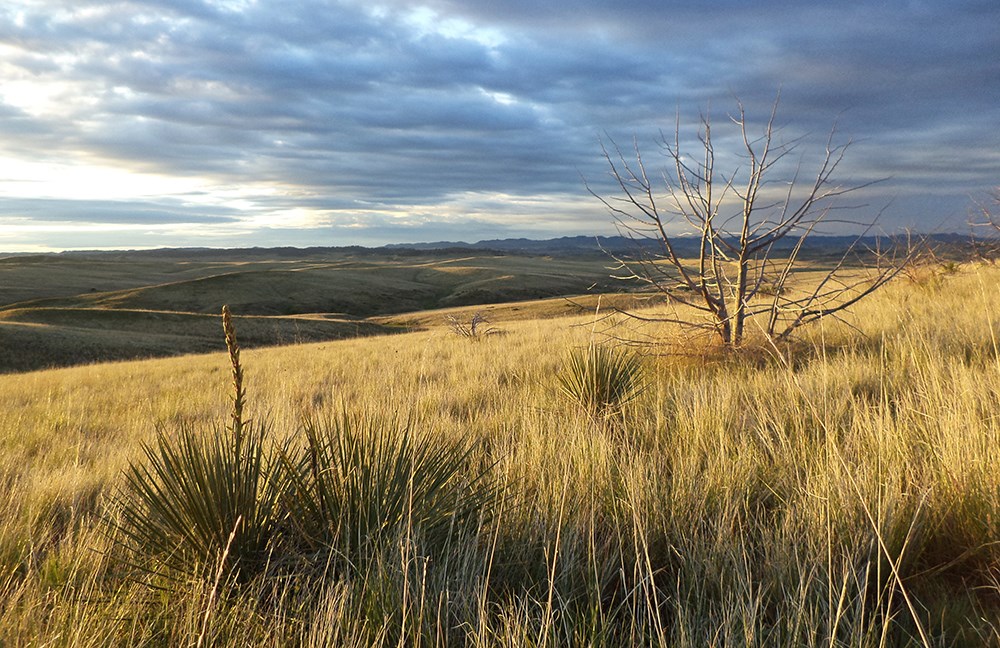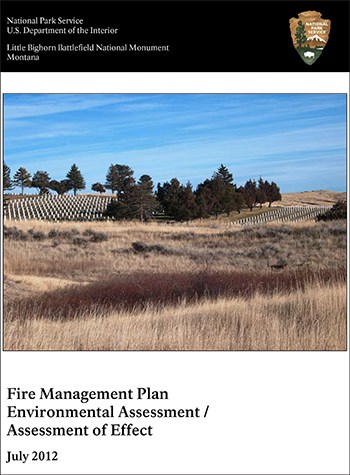Last updated: October 14, 2024
Article
Grassland Fire Ecology Resource Brief
Background Information

NPS
Threats
For Little Bighorn Battlefield National Monument, managing wildfire is a balancing act. Wildfire occurrence serves a crucial role in grassland ecology. One of the monument’s main objectives, however, is to protect artifacts from the battle—artifacts that could be destroyed in a fire. Park buildings and other structures also need protection. In order to ensure both the health of the land and the monument’s history, park managers are creating a management plan that respects both priorities. Managers allow fires to burn to some extent, but take action to suppress them before they threaten the monument’s assets. Unfortunately, fires are not very predictable, especially with the added factor of accidental human-caused ignitions. Visitors must be fire-conscious and do their part to help prevent human-caused wildfires.
History engulfs the Little Bighorn Battlefield National Monument. Most think of the human history, but the land tells a story too. Fire is an integral character in that story. Wildfire helped shape the grassland where the Battle of Little Bighorn took place. Historically, bluebunch wheatgrass, Sandberg bluegrass, and junegrass populated the native grassland ecosystem. Grasslands can exist in a variety of climates, but they share several important characteristics: dry seasons or dry spells, and rolling terrain with prevailing winds. Dry vegetation and winds also serve as major ingredients for fire.
Wildfire has a reputation as a destructive force, but it often functions to maintain an ecosystem’s balance. Regular wildfires shape the makeup of vegetation by suppressing woody plants and favoring grasses. Because their growth structure is situated at or below the ground, and because fire moves quickly through grasslands, most grasses tolerate fire or even proliferate after a fire. Without fire, shrubs and trees would take over grasslands, effectively converting them to forest, and non-native vegetation would spread.
While lightning is the natural source of ignition for wildfire, archeological and historical evidence shows that Native Americans also started fires to drive game, harvest grains and nuts, enrich the soil for agriculture, clear land for travel, or as an offensive and defensive weapon in battle. Animals, too, rely on the relationship between land and fire; for example, studies show that bison prefer grass from more recently burned areas.
Status and Trends
While historical accounts of the land before the battle are limited, research in the northern plains indicates similar landscapes typically burned once every two or three decades prior to European settlement. The fire history after the battle is better known. The documented presence or absence of shrubs like sagebrush establishes the timeline of major burns in the area. Large fires can remove sagebrush, which may require several decades to recover.
After the United States Cavalry battled the Sioux and Cheyenne on June 25–26, 1876, the Sioux and Cheyenne ignited the grass west of the Little Bighorn River to cover their retreat. Because the fire-intolerant sagebrush had been noted at the time of the battle, these battle ignitions were likely the first fires on the grassland in decades.
The several decades following the battle were also apparently free of major fires. Photo evidence indicates an abundant recovery of big sagebrush on the battlefield at this time. Several factors contributed to this sustained lack of fire. The reservation era brought an end to Native American land-use burning practices, and the expansion of agriculture on the plains resulted in fewer fires and greater fire suppression.
An intense fire swept across 90% of the monument in August of 1983. This burn helped to fend off encroaching shrubs and invasive species, and allowed for a reseeding of native grasses. Thanks to this fire and several more to follow, the land at the monument resumed much of its historic and natural character. Because of careful management practices, native vegetation still dominates at Little Bighorn.
The fire season runs from July through September. The wind-driven fires that strike the monument grow large and move swiftly. They typically last one or two days because of the light and flashy nature of grassland fuels. Unfortunately, most fires are human caused rather than natural.

NPS
Management Strategy
The National Park Service allows for natural processes to take their course whenever practical and when they do not interfere with park unit management objectives. In this case, Little Bighorn’s objective to preserve historical and cultural resources supersedes the perpetuation of natural processes. Still, the monument recognizes wildfire as a fundamental aspect of the grassland’s ecological health, and incorporates fire management into its strategic planning.
In March of 2012, Little Bighorn Battlefield announced the preparation of a new fire management plan and environmental assessment for the monument. The goals of the new plan are to ensure the health and safety of the public, NPS staff, and firefighters; to protect cultural and natural resources; and to maintain a healthy and sustainable ecosystem.
Through education, monument staff hope to emphasize the value of wildfire to the ecosystem while recognizing the need to protect cultural resources, public property, and people.
Resources for More Information
Glacier National Park Staff
- Christopher Ziegler, Chief of Cultural and Natural Resources, Little Bighorn Battlefield National Monument
- Denice Swanke, Superintendent, Little Bighorn Battlefield National Monument
Documents and web sites
- Little Bighorn Battlefield Website – www.nps.gov/libi
- Little Bighorn Battlefield Fire Management –https://parkplanning.nps.gov/projectHome.cfm?parkID=77&projectID=40378
- Smoak, Gregory E. Review Draft June 2012. An Environmental History of Little Bighorn Battlefield National Monument. Colorado State University Public Lands History Center. Ft. Collins, Colorado, USA.
The Crown of the Continent Research Learning Center
Phone: 406-888-5827; Email: melissa_sladek@nps.gov
Website: www.nps.gov/rlc/crown
